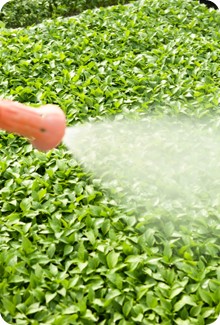Pesticide spray drift near homes
What is pesticide spray drift?
Pesticide spray drift happens when a pesticide stays in the air long enough to drift off the area being sprayed and onto other areas by accident. Spray drift near your home could come from pesticides being applied to lawns, gardens, parks, or nearby farming areas.
Drift depends on many things, like weather conditions and the type of spray equipment being used. Because spray drifts downwind from the place being treated, the farther away you are from the area being sprayed, the less drift there is.
Pesticides that are sprayed can include herbicides, insecticides, and fungicides.

Did you know?
Although some pesticides can have a strong smell that may be unpleasant, the odour itself is not harmful and tends to go away quickly. In agricultural areas, fertilizers may also be a source of strong odour.
Tips to reduce spray drift
If you want to apply a pesticide to your lawn or garden, you are responsible for using it safely. It is also important to know about provincial, municipal, and local regulations for using pesticides. See Cosmetic pesticide bans for more information.
You can minimize pesticide use, as well as your risk of being exposed, with these tips:
- Learn about pests and how to control them using our Pest control tips.
- Follow our tips on how to have a healthy lawn to prevent problems from starting.
- Read, understand, and follow all directions and safety tips on pesticide labels.
- Wear personal protective equipment if recommended on the label.
- Avoid spraying pesticides when other people or animals are present.
- Let neighbours know if you plan to spray pesticides.
Consider using spot treatments on problem areas instead of spraying pesticides on a larger area. This reduces spray drift as well as the overall amount of product used.
To reduce spray drift when applying pesticides, avoid spraying when:
- there is no wind
- the wind is high or gusty
- it is very dry
- it is foggy or drizzly
You may also choose to hire a professional pesticide applicator. Professional applicators are trained and certified to safely use pesticides. They also know how to choose equipment that minimizes spray drift. They must follow provincial rules for buffer zones, and maximum allowable wind speeds when applying pesticides.
Protecting yourself from spray drift
When pesticides are used normally and according to the label directions, pesticide residues from spray drift are not a concern for the people using them or for bystanders. But a large amount of spray drift into non-target areas could affect health and the environment.
If someone is spraying pesticides near your home and you are concerned, you can take safety steps like:
- closing windows
- removing and/or covering outdoor toys and eating areas
- keeping kids and pets indoors
- avoiding being close to the area being sprayed
You can report concerns about spray drift incidents to your provincial or territorial government.
Questions about health or environmental concerns related to pesticides can be directed to Health Canada's Pest Management Information Service.
How we protect you
Health Canada restricts how pesticides can be used. When a pesticide is first considered for registration or is being re-evaluated, we look at the impact of pesticide spray drift on people and the environment. We also make sure that pesticide labels have directions that include advice on how to minimize spray drift.
Examples of label directions that we may insist on include:
- requiring certain types of application equipment to be used
- providing instructions to spray only at certain times of the day and only in weather conditions that will minimize drift
- stating the amount of pesticide that may be used for a given area
- establishing an untreated area, called a buffer zone, between an area to be treated and any nearby area that must be protected
Health Canada and provincial authorities have developed national standards for pesticide education, training, and certification in Canada. This includes ways to reduce spray drift to non-target areas. We also monitor use and enforce compliance with the Pest Control Products Act to make sure the rules are being followed.
Page details
- Date modified: